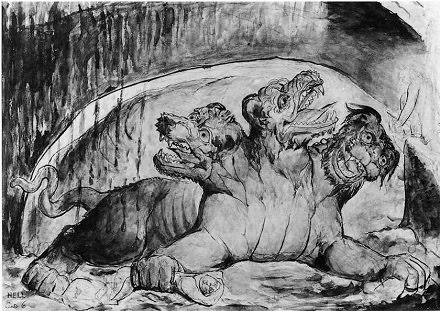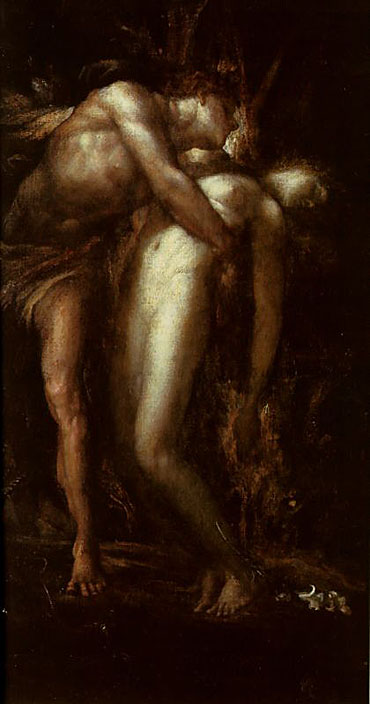Hades and the Afterlife
Three major ancient authors taken together provide a composite and virtually complete summary of the philosophical and religious beliefs about the afterlife evolved by the Greeks and Romans: -1) Homer, Odyssey, Book 11, the Nekuia (“The Book of the Dead”); -2) Plato, Republic, the myth of Er, which concludes Book 10; -3) Vergil, Aeneid, Book 6.
Eleusinian Mysteries
TRADITIONAL ELEMENTS OF THE REALM OF HADES AND PERSEPHONE
Hades. Called DIS, PLUTO (both names mean wealth) by the Romans, Hades is a god of agricultural plenty and the king of the Underworld. He and other deities of his realm are known as chthonian, “of the earth.”
Persephone. Queen of the Underworld and Hades’ wife.
Tartarus. The name of the realm as a whole or the place of punishment, i.e., Hell.
Erebus. The darkness of Tartarus, or another name for Tartarus itself.
Elysium, the Elysian Fields. Paradise in the Underworld.
The Three Judges. MINOS, RHADAMANTHUS, and AEACUS. They pass sentence on the just and unjust souls.
The Five Rivers. STYX, the river “of hate”; ACHERON, “of woe”; LETHE, “of forgetfulness”; COCYTUS, “of wailing”; PHLEGETHON, “of fire.”
The Ferryman. Charon transports souls across a river, Styx or Acheron. He demands as fare the coin that is buried in the mouth of a corpse. Proper burial is essential.
Hermes Psychopompus. Hermes as “leader of the soul” takes our souls, after death, to Charon.
The Hound of Hades. The dog Cerberus guards the realm. He is ferocious and usually is depicted with three snarling heads.
http://www.oup.com/us/companion.websites/9780195397703/student/materials/chapter15/?view=usa
Cerebus

William Blake
PLATO’S MYTH OF ER
After his soul had departed, it traveled with many other souls and came to a divine place where there were two openings in the earth; opposite were two other openings in the upper region of the sky. In the space between these four openings were judges who passed sentence. They ordered the just to go to the right through one of the openings upward into the sky, but they sent the unjust to the left through one of the downward openings.
Er also saw from the remaining two openings some souls coming up out of the earth, covered with dust and dirt, and others descending from the sky, pure and shining. When they were all reunited on the plain, they recounted their experiences.
The Sinners. The first group from out of the earth wept as they recounted their torments, which lasted one thousand years. Everyone had to suffer an appropriate penalty for each sin, ten times over. Those who were extraordinarily wicked (such as the evil tyrant Ardiaeus), guilty of many murders and other unholy deeds were never allowed to return out of the earth; but wild men of fiery aspect seized and flayed them and hurled them down into Tartarus.
The Virtuous. The second group, on the other hand, who had descended from the opening in the sky, told of the great happiness that they had felt and the sights of indescribable beauty that they had seen as they completed their cycle of one thousand years.
The Choosing of a New Life. All these souls, sinful and virtuous alike, proceeded on another journey to arrive at a special place which provided a cosmic view of the universe, controlled by the spindle of Necessity and her daughters, the three Fates, and where the Sirens’ song echoed the harmony of the spheres. In this place, each soul had to pick a lot and choose from examples of lives before beginning the next cycle of mortality. In front of these souls were placed the examples of every kind of life possible for human beings and for all living creatures. All-important was the choice that a soul would make; it must have learned from its experiences in life and in death to know the difference between the good life and the wicked, and always choose the better rather than the worse. This is the crucial choice for a human being always, whether living or dead, and the choice is the individual’s own; god is blameless.
Rebirth and Reincarnation. When all the souls had chosen their lives, whether wisely or foolishly, each was given a divine guardian spirit. After certain ordained procedures, they came to LETHE, the river of “forgetfulness,” where it was necessary that they drink a certain amount (some were unwise and drank too much). As they drank, they became forgetful of everything and fell asleep. In the middle of the night, amidst thunder and an earthquake, suddenly they were carried upward just like shooting stars, each in a different direction, to be reborn.
Plato has a similar account of the afterlife in the Phaedo. He explains that true philosophers who have lived a holy life are eventually released from this cycle of reincarnation and entirely as souls inhabit beautiful dwellings. In each of our lives in this world and in each of our periods of reward or punishment in the afterlife, we are supposed to learn and become wiser and proceed upward spiritually.
The Platonic Afterlife. Plato is writing in the fourth century B.C., and his vision of the afterlife is far different from Homer’s. Not only do human beings have a body and a soul, but moral and religious philosophy has developed concepts of virtue and sin, which merit reward and punishment in the next life, and a theory of rebirth, reincarnation, and the transmigration of souls, all of which provide dogma for mystery religions.
http://www.oup.com/us/companion.websites/9780195397703/student/materials/chapter15/?view=usa
VERGIL’S BOOK OF THE DEAD
Aeneas and His Guide, the Sibyl. Aeneas’ entrance to the Underworld is at Cumae in Italy, and his guide is the Cumaean SIBYL, priestess of Apollo. After appropriate sacrifices, Aeneas and the Sibyl enter the Underworld and reach the banks of the river that is its boundary. The grim ferryman CHARON refuses to take across in his boat those who are unburied; among them is PALINURUS, the helmsman of Aeneas, who had died without having received burial. In an interview reminiscent of that between Odysseus and Elpenor in Homer, Palinurus receives assurances from Aeneas that his body will receive proper rites.
Once a reluctant Charon sees the golden bough, he agrees to ferry Aeneas and the Sibyl across; on the other shore the three-headed hound of Hades, CERBERUS guards the realm. The Sibyl throws him a drugged sop, which he devours eagerly. As the two proceed on their way, they pass through various regions (the geography of Vergil’s Underworld is quite detailed). One of these regions is called the Fields of Mourning. This is where Aeneas encounters DIDO, queen of Carthage, who had committed suicide when Aeneas left her. They come to a place where the road divides; on the left, the path leads to TARTARUS, on the right to ELYSIUM.
Tartarus (Hell). This is the place of punishment for sinners, the Greco-Roman concept of hell. In Vergil it is a triple-walled, invincible fortress with a huge door, mighty columns, and an iron tower, and it is surrounded by a seething, violent river. One of the dread Furies stands guard. From within come horrible sounds of suffering. The Sibyl expounds to Aeneas the nature of sin and its punishment and concludes by saying that she would not be able to recount all the forms of wickedness or enumerate the names of all the punishments, even if she had a hundred tongues.
Elysium or the Elysian Fields (Paradise). When they come to the happy places, the pleasant glades of the woods of the Fortunate, Aeneas and the Sibyl find that all is bright, for paradise has its own sunlight. Shades, wearing halos of snowy white garlands on their temples, are enjoying themselves in the pleasant activities that they pursued while alive. Some delight in sports; others appreciate music and dance under the inspired direction of the bard Orpheus.
Amidst the virtuous are patriots who died for their country, priests who remained pure, and devout poets who were worthy of their god, Apollo. Vergil singles out with magnanimous insight, “those who made life better by their discoveries in the arts and the sciences and who through merit made others remember them.”
The climax of the scene is Aeneas’ touching encounter with his father, ANCHISES, who reveals the mysteries of human existence. The mother of Odysseus had done the same for her son, but her explanation was more personal and not nearly so civic, detailed, and philosophical. A more Platonic Anchises explains that a divine spirit or mind sustains the universe, and the souls of mortals are but seeds from this divine spirit. Enclosed by the prison of an earthly, harmful, and mortal body, the immortal soul becomes contaminated and must be purified before it comes to Elysium. Anchises points out the group of souls gathered by the stream of Lethe, who must drink of this river of forgetfulness before they are enter a new life. In this group Anchises identifies a long array of great and illustrious Romans who are yet to be born.
http://www.oup.com/us/companion.websites/9780195397703/student/materials/chapter15/?view=usa
Orpheus and Eurydice
